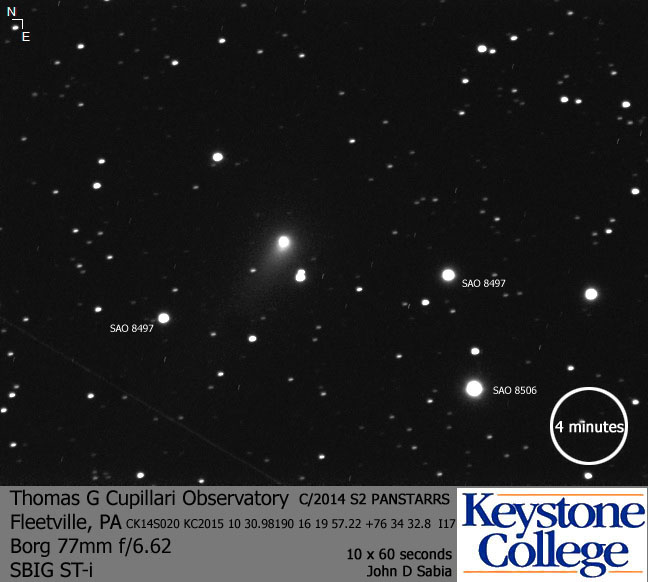ALPO COMET SECTION NEWS FOR NOVEMBER 2015
2015-November-03
Evening Comets
C/2014 S2 (PANSTARRS) [Perihelion on 2015-Dec-09 at 2.10 AU from the Sun]
October’s brightest comet, for those of us at northern latitudes, was C/2014 S2 (PANSTARRS). At around magnitude 9.5-10.0, it is located in the northern circumpolar sky as it moves from Ursa Minor (Nov 1-15) into Draco (15-30). The comet is still inbound as it gets closer to the Sun (2.15 to 2.10 AU) and Earth (1.87 to 1.91 AU) and may brighten another 0.5 magnitudes as it reaches its early December perihelion.
22P/Kopff [Perihelion on 2015-Oct-25 at 1.56 AU from the Sun]
Comet Kopff’s 2015 perihelion passage is its 16th since its discovery in 1919. This month Kopff is around 10th magnitude as it moves through Ophiuchus (Nov 1-6) and Sagittarius (6-30). It will move slowly away from the Sun (1.56 to 1.61 AU) and Earth (2.12 to 2.29 AU) as it is over a month past its late October perihelion.
C/2014 Q2 (Lovejoy) [Perihelion on 2015-Jan-30 at 1.29 AU from the Sun]
A year ago comet C/2014 Q2 (Lovejoy) was rapidly brightening on its way to being a naked eye object. Amazingly Lovejoy is still visible in reasonably sized backyard telescopes even at large distances from the Sun (3.78 to 4.09 AU) and Earth (4.28 to 4.72 AU). It can be seen at ~11-12th magnitude as it moves through Hercules (Nov 1-30).
Morning Comets
C/2013 US10 (Catalina) [Perihelion on 2015-Nov-15 at 0.82 AU from the Sun]
The brightest comet in the sky is currently behind the Sun and invisible. This state of affairs will change by the end of the month as C/2013 US10 (Catalina) races north through Hydra (Nov 1), Libra (1-15) and Virgo (15-30). Although its distance from the Sun has been decreasing, the comet has stayed steady at around magnitude 6.5 for the past 3 months. Intrinsically this means the comet has actually faded. What this means for the future is unknown though it is possible the comet experienced an outburst in late July or August and has spent the last few months fading back to “normal”.
Comet Catalina starts the month at 0.87 AU from the Sun, reaches perihelion at 0.82 AU from the Sun on the 15th and ends the month again at 0.87 AU. It is still rather far from Earth though this distance will shrink from 1.82 AU to 1.51 AU. Visibility will be difficult till the end of the month when it rapidly gains elevation in the morning sky. Observers south of the equator will still have a difficult time observing Comet Catalina.
C/2013 X1 (PANSTARRS) [Perihelion on 2016-Apr-20 at 1.31 AU]
C/2013 X1 may be brightening fast. Recent visual reports place it between magnitude 10.5 to 11.5. This month the comet should brighten another half to full magnitude as it cruises through Perseus (Nov 1-20) and Andromeda (20-30) and moves closer to the Sun (2.70 to 2.37 AU) and Earth (1.85 to 1.53AU). Discovered back in December of 2013, X1 is still over 5 months from perihelion and 7 months from its closest approach to Earth (0.64 AU in late June). This comet should be a nice small telescope object as it stays brighter than magnitude 10 for much of 2016. Peak brightness may be around magnitude 6 or 7 next June.
67P/Churyumov-Gerasimenko [Perihelion on 2015-Aug-13 at 1.24 AU]
The Rosetta mission target is now well past perihelion and will move from 1.57 to 1.79 AU from the Sun while moving slightly closer to Earth (1.80 to 1.74 AU). It is still around magnitude 12 as it moves through Leo.
New Discoveries
C/2015 T2 (PANSTARRS) is faint and far away. Perihelion for this long-period comet will not occur until the Spring of 2017 at 7.1 AU. It will not get much brighter than its current 20th magnitude.
P/2015 T3 (PANSTARRS) is a short-period comet with a period of 9.0 years. Perihelion occurred last December at 2.12 AU. Currently at 20th magnitude it may have been only a magnitude brighter a year ago.
C/2015 T4 (PANSTARRS) is yet another Pan-STARRS find from the past month. T4 is a long-period comet but appears to be dynamically old suggesting it may get a little brighter than predicted say 14th-15th magnitude versus 16th magnitude. Perihelion happens next June at 2.30 AU.
P/2015 TO19 (Lemmon-PANSTARRS) was found by both D. C. Fuls of the Mount Lemmon Survey and Pan-STARRS. It has probably already hit its peak at 19th magnitude. A short-period comet, TO19 is on a 9.75 year orbit with perihelion next March at 2.93 AU.
C/2015 TQ209 (LINEAR)… they’re baaack! For about 10 years starting in the late 90’s, it seemed like every other bright comet was a comet LINEAR. Back then they used a number of 1.0-m telescopes. Now LINEAR is back and using the 3.5-m Space Surveillance Telescope (SST). Their first find with the SST is 19th magnitude but may reach 13th magnitude around its August 2016 perihelion (1.41 AU). Its orbit has a low inclination so there is a chance it is actually a short-period comet with a larger perihelion distance.
As always, the Comet Section is happy to receive all comet observations, whether images, drawings or magnitude estimates.
- Carl Hergenrother (ALPO Comet Section Coordinator)




